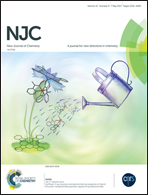Comparison of Co(ii) adsorption by a crosslinked carboxymethyl chitosan hydrogel and resin: behaviour and mechanism
Abstract
A crosslinked carboxymethyl chitosan hydrogel (CCMCH) and resin (CCMCR) are prepared via the cross-linking of glutaraldehyde. The adsorption behavior and mechanism of CCMCH and CCMCR are studied for the removal Co(II) from wastewater and their differences have been studied. The results indicate that their adsorption occurs mainly by chemical adsorption mechanism. However, the Co(II) adsorption process on CCMCH is accompanied by physical adsorption. The maximum adsorption capacities for Co(II) uptake are 72.84 and 60.03 mg g−1 for CCMCH and CCMCR, respectively, under optimized conditions. The adsorption of Co(II) on CCMCH and CCMCR are both well fitted by the Langmuir isotherm and pseudo-second-order model. Also, the data of the adsorption kinetics for Co(II) on CCMCH follows the pseudo-first-order model. Analyses from FTIR and supplemental experiments confirm that the functional groups, including amino, hydroxyl, and carboxyl groups, are involved in the adsorption process.



 Please wait while we load your content...
Please wait while we load your content...